Understanding Mango Varieties 🥭
Unlike oranges, where the differences in taste between varieties are more subtle, mangoes can have very different flavor profiles and uses. You can usually differentiate the variety by looking at the skin color and shape. The first step to deciding which type of mango to buy is to determine your usage. While they are commonly eaten as a snack or dessert, they can also be used for salads, smoothies, and cooking.
Mango Variety Comparison Table 🥭
| Variety | Also Called | Commonly Found In | Color | Flavor | Texture | Key Difference |
|---|---|---|---|---|---|---|
| Tommy Atkins | Supermarket Mango | Americas, Global | Red, green, yellow | Mildly sweet | Firm, slightly fibrous | Less sweet, widely available. |
| Ataulfo Mango | Honey Mango, Champagne Mango | Mexico, Americas, Asia | Golden yellow skin | Sweet, creamy | Smooth, fiberless | Small, sweet, and buttery texture. |
| Kent Mango | Green and Red Mango | Americas, Global | Green and red | Sweet, juicy | Smooth, creamy | Sweeter than Tommy Atkins, fewer fibers. |
| Keitt Mango | Late-Season Mango | Americas, Global | Green, even when ripe | Sweet, tangy | Firm, smooth | Stays green when ripe, great for salads. |
| Haden Mango | Florida Mango | Americas | Bright red with yellow | Sweet, tangy | Juicy, slightly fibrous | Bright red skin, classic mango flavor. |
| Alphonso Mango | Hapus, King of Mangoes | India | Golden yellow with red blush | Rich, sweet, aromatic | Creamy, fiberless | Highly prized for its flavor and aroma. |
| Philippine Mango | Carabao, Manila Mango | Philippines | Bright yellow skin | Exceptionally sweet | Juicy, fiberless | Known as one of the sweetest mangoes. |
| Thai Mango | Nam Dok Mai | Thailand | Golden yellow skin | Sweet, creamy, aromatic | Smooth, fiberless | Perfect for sticky rice and desserts. |
| Apple Mango | Manzano Mango | Mexico, Central America | Green, red, yellow skin | Sweet, hints of apple | Smooth, fiberless | Small and apple-like flavor. |
| Thai Green Mango | Unripe Mango | Thailand | Green skin | Tart, crisp, slightly sour | Firm, crunchy | Used in tangy salads and savory dishes. |


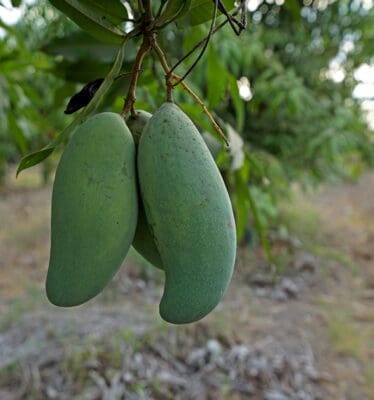
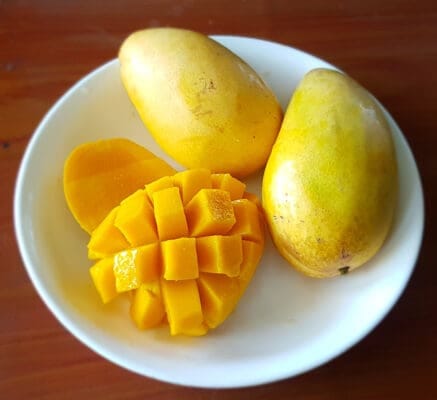
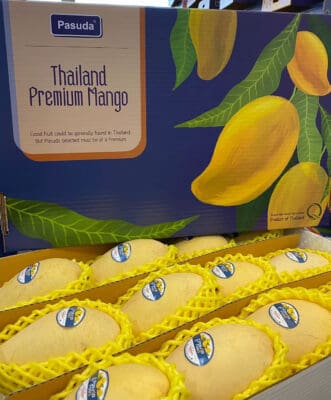
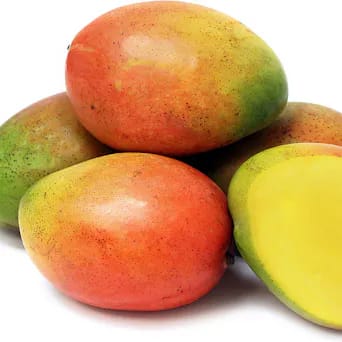

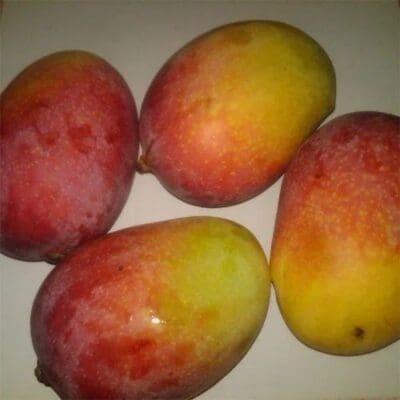
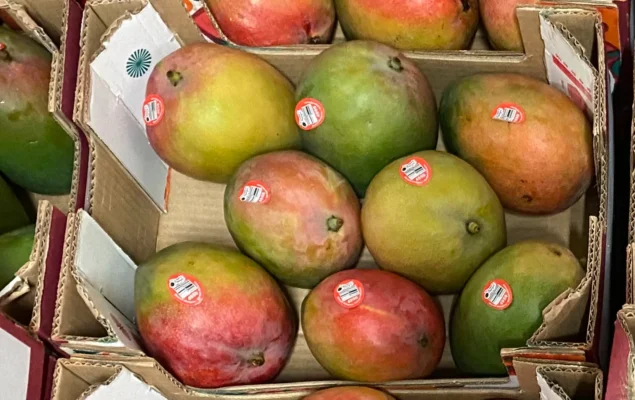
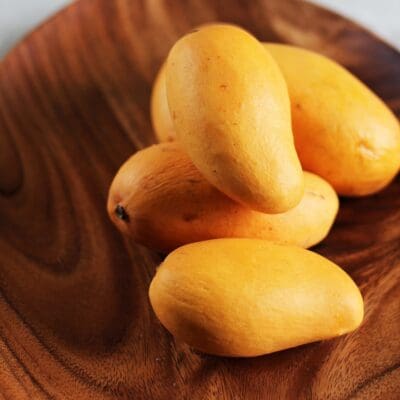
Mango Usage 🍽️
1. Eating/Snacking
Mangoes are a popular snack, loved for their sweet, juicy flesh. Some varieties are especially well-suited for eating fresh:
- Ataulfo Mango: Known for its creamy, fiberless texture and honey-like sweetness, it’s one of the most popular mangoes for snacking.
- Kent Mango: Sweet and juicy with minimal fibers, making it a favorite for fresh eating.
- Alphonso Mango: Rich, aromatic, and incredibly sweet, it’s a premium choice for enjoying on its own.
- Philippine Mango: Exceptionally sweet and fiberless, it’s perfect for snacking.
2. Salads
Mangoes add a sweet, tropical twist to salads. Firm and slightly tangy varieties work best:
- Keitt Mango: Stays firm even when ripe, making it ideal for green salads and grain bowls.
- Tommy Atkins: Holds its shape well and adds a mild sweetness to salads.
- Thai Green Mango: Tart and crisp, it’s a staple in Thai salads like Som Tum (green papaya salad).
3. Smoothies
Mangoes are a fantastic addition to smoothies, adding natural sweetness and creaminess. Sweet and fiberless varieties work best:
- Ataulfo Mango: Its smooth texture and honey-like sweetness make it perfect for smoothies.
- Kent Mango: Juicy and sweet, it blends well into smoothies.
- Alphonso Mango: Rich and aromatic, it adds a luxurious flavor to smoothies.
4. Cooking
Mangoes can be used in both sweet and savory dishes. Firmer, less sweet varieties are great for cooking:
- Thai Green Mango: Its tartness works well in savory dishes, stir-fries, and chutneys.
- Tommy Atkins: Mildly sweet and firm, it’s versatile for cooking in curries or salsas.
- Haden Mango: Its sweet-tangy flavor complements grilled meats and seafood.
5. Desserts
Mangoes are a star ingredient in many desserts, especially sweet and creamy varieties:
- Ataulfo Mango: Its smooth texture and honey-like sweetness make it perfect for mango sticky rice, smoothies, and sorbets.
- Alphonso Mango: Rich and aromatic, it’s ideal for mango lassi, ice cream, and cakes.
- Thai Mango (Nam Dok Mai): Sweet and creamy, it’s a favorite for desserts like mango sticky rice and fruit salads.

What to Look For 🔍
When choosing a mango, consider the following:
- Ripeness:
- Gently squeeze the mango. It should yield slightly to pressure, like a ripe peach.
- Check the color, but note that some varieties (like Keitt) stay green even when ripe.
- Smell the stem end—a sweet, fruity aroma indicates ripeness.
- Firmness:
- Firmer mangoes are better for salads and cooking, as they hold their shape.
- Softer mangoes are ideal for snacking, smoothies, and desserts.
- Fragrance: Some mango varieties, like Alphonso, are highly aromatic, which can indicate sweetness and flavor.
- Weight: A ripe mango will feel heavy for its size, indicating juiciness.
What to Avoid 🚫
- Too soft: These may be overripe and starting to go bad.
- Hard: Hard mangoes are less ripe, unless that’s the taste you’re aiming for.
- Bruised or Damaged: These may have spoiled flesh inside.
- Black spots: Large black spots could indicate spoilage or damage. Smaller black spots could indicate bacterial infection on the skin which may not may not have affected the flesh. Some small black spots may be normal. When in doubt, pick the ones without any black spots.
- Wrinkled and Dry: Overripe mangoes may have a fermented smell or be too mushy.
- Large seeds: Some varieties have larger seeds, meaning if you paid by weight, you’re getting less value for your money.
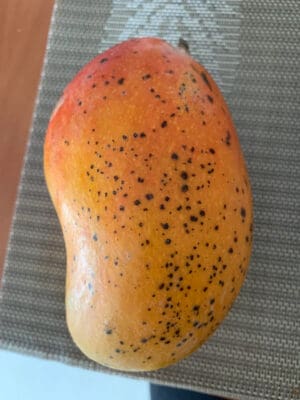
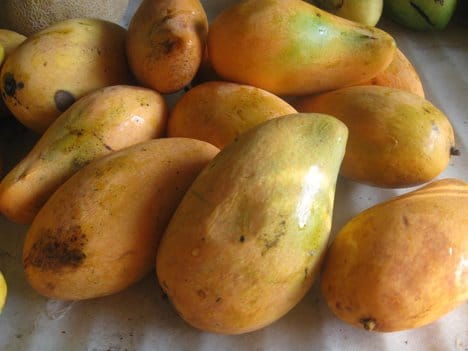
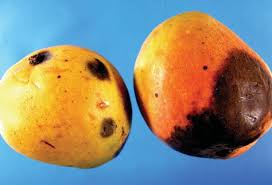
Storage Tips
- Room Temperature: Store unripe mangoes at room temperature to allow them to ripen naturally. Keep them in a cool, dry spot away from direct sunlight.
- Refrigeration: Once ripe, store mangoes in the fridge to slow further ripening. They can last up to 5 days.
- Freezing: Peel, slice, and freeze mangoes in an airtight container or bag for up to 6 months. Perfect for smoothies or desserts.
How to Cut or Process Mangoes
- Wash the Mango: Rinse the mango under cool water to remove any dirt or residue.
- Find the Seed: Mangoes have a flat, oblong seed in the center. Hold the mango vertically and slice about ¼ inch off each side (the “cheeks”) to avoid the seed.
- Score the Flesh: Use a knife to make lengthwise and crosswise cuts in the mango flesh, creating a grid pattern. Be careful not to cut through the skin.
- Scoop or Peel: Push the skin inward to turn the mango inside out, then slice off the cubes. Alternatively, peel the skin with a knife or vegetable peeler and slice the flesh off the seed.
- Use the Seed: Don’t waste the seed! Trim off any remaining flesh and enjoy it as a snack.
Why Mangoes? 🌟
Mangoes are not only delicious but also packed with nutrients and versatility:
- Nutritious: Rich in vitamins A and C, fiber, and antioxidants.
- Versatile: Perfect for snacking, cooking, salads, smoothies, and desserts.
- Tropical Flavor: Their sweet, juicy taste brings a taste of the tropics to any dish.
- Easy to Enjoy: Simply peel and eat, or use in a variety of recipes.
- Global Appeal: Loved worldwide, mangoes are a staple in cuisines from Asia to the Americas.
